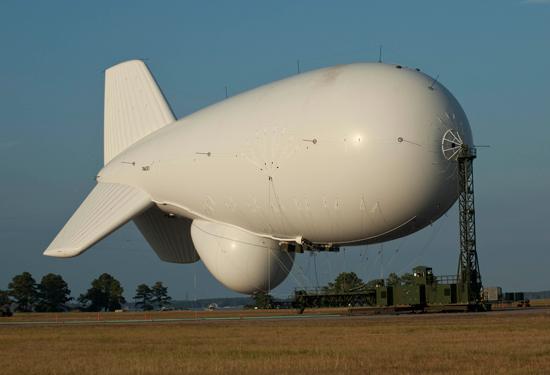The U.S. military plans to deploy two massive surveillance blimps over Aberdeen, Md., next year, and nobody is worried. According to Raytheon, which spearheaded the $450 million project, the Joint Land Attack Cruise Missile Defense Elevated Netted Sensor System (JLENS) will be able to simultaneously monitor hundreds of threats at a time. In addition to keeping watch for incoming cruise missiles and hostile aircraft, JLENS is also capable of monitoring targets on the ground and at sea, including individual vehicles and small boats. Its 340-mile range includes most of the Northeast corridor, stretching from Raleigh, N.C., to Boston, as well as Toronto and Cleveland to the north and west.
JLENS is just one program in a growing arsenal of lighter-than-air defense technologies. Despite all of their surveillance capabilities, military blimps aren’t on most American’s radars, even with growing concern over drone use by domestic law enforcement agencies.
Outside of names like Predator, what is it about drones that make them scarier than blimps? Many equate blimps with sporting events; like some sort of like airborne Oscar Mayer Wienermobiles. Perhaps we imagine the JLENS orbit, a two-blimp system floating around 10,000 feet, as a benevolent Big Brother/Goodyear-blimp hybrid, protecting us from above.
But these blimps are hardly innocuous: While technically unarmed, the aerostats (a fancy word for a tethered blimp) are equipped with a fire-control radar system that provides coordinates to defense networks on the ground that can then mitigate (see: blow up) any threats. Just call them bubble drones.
So, in a region relatively free of enemy cruise missiles, what purpose will JLENS serve?
While the price tag seems hefty, JLENS is likely much cheaper than existing defense response systems, many of which are already in effect. Each aerostat is capable of handling a 4,500-pound payload with no fuel, needing only a monthly helium-top off before resuming its silent, continuous surveillance of the region. Fixed-wing aircraft like those used in Operation Noble Eagle guzzle gas, create noise, spew pollution, and have to land and refuel more frequently. It remains to be seen whether JLENS is meant to be a supplemental technology or a replacement for older systems.
JLENS is likely to be on the lookout for drones. As unmanned aerial vehicles become more accessible to commercial and private users, security experts are concerned with their use for terrorist or criminal activities. As many of these devices may be difficult to track, they present a legitimate national security concern that JLENS may help solve.
And in the event that a missile is launched at a U.S. city, JLENS turns seconds of advance warning into minutes. It not only engages threats much faster than existing technologies, but also allows more time to warn citizens who may be in danger to seek shelter.
While military representatives associated with the project deny that JLENS will be used for ground surveillance, a recent Raytheon press release touts the distinct ability to do so:
“[D]espite heavy smoke from recent, naturally-occurring forest fires, an MTS-B electro-optical/infrared (EO/IR) sensor mounted on a JLENS surveillance aerostat tracked numerous targets with the IR sensor. Video from the MTS-B was passed through the aerostat’s tether, enabling operators to watch live feed of trucks, trains and cars from dozens of miles away. While the MTS-B visually tracked targets, the JLENS simultaneously tracked surface targets with its integrated radar system.”
In other words, a JLENS aerostat equipped with MTS-B (Multi-Spectral Targeting System) can successfully monitor multiple cars and trucks at long range. Through the billowing black smoke of a massive forest fire. But can it monitor people?
Raytheon also describes one scenario where operators observed a “terrorist role-player planting an improvised explosive device—in real time.” But what happens to the thespian terrorist? (Side note: Are there auditions for this role?)
Ka-boom. Our bubbly friend “provides long-range surveillance, target acquisition, tracking, range- finding and laser designation for the HELLFIRE missile and all tri-service and NATO laser-guided munitions.” After locking on to a target, JLENS sends real-time coordinates through its elaborate, Kevlar-coated communications tethers, allowing missile defense systems on the ground to train their lasers on a target they can’t even see yet.
Blimps don’t seem so cute anymore.
